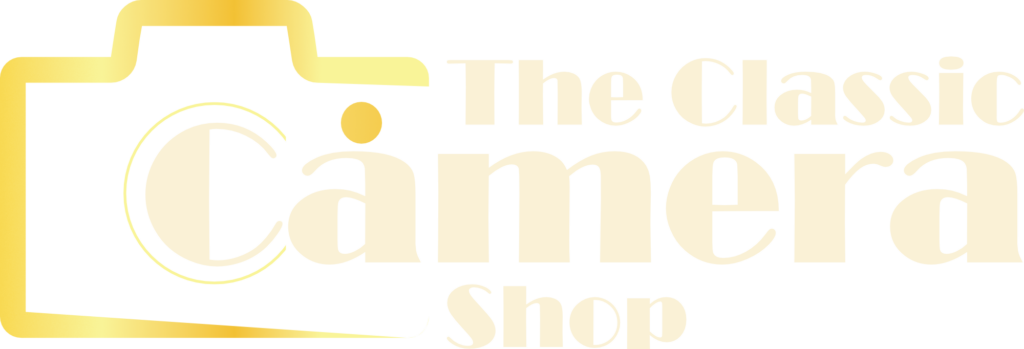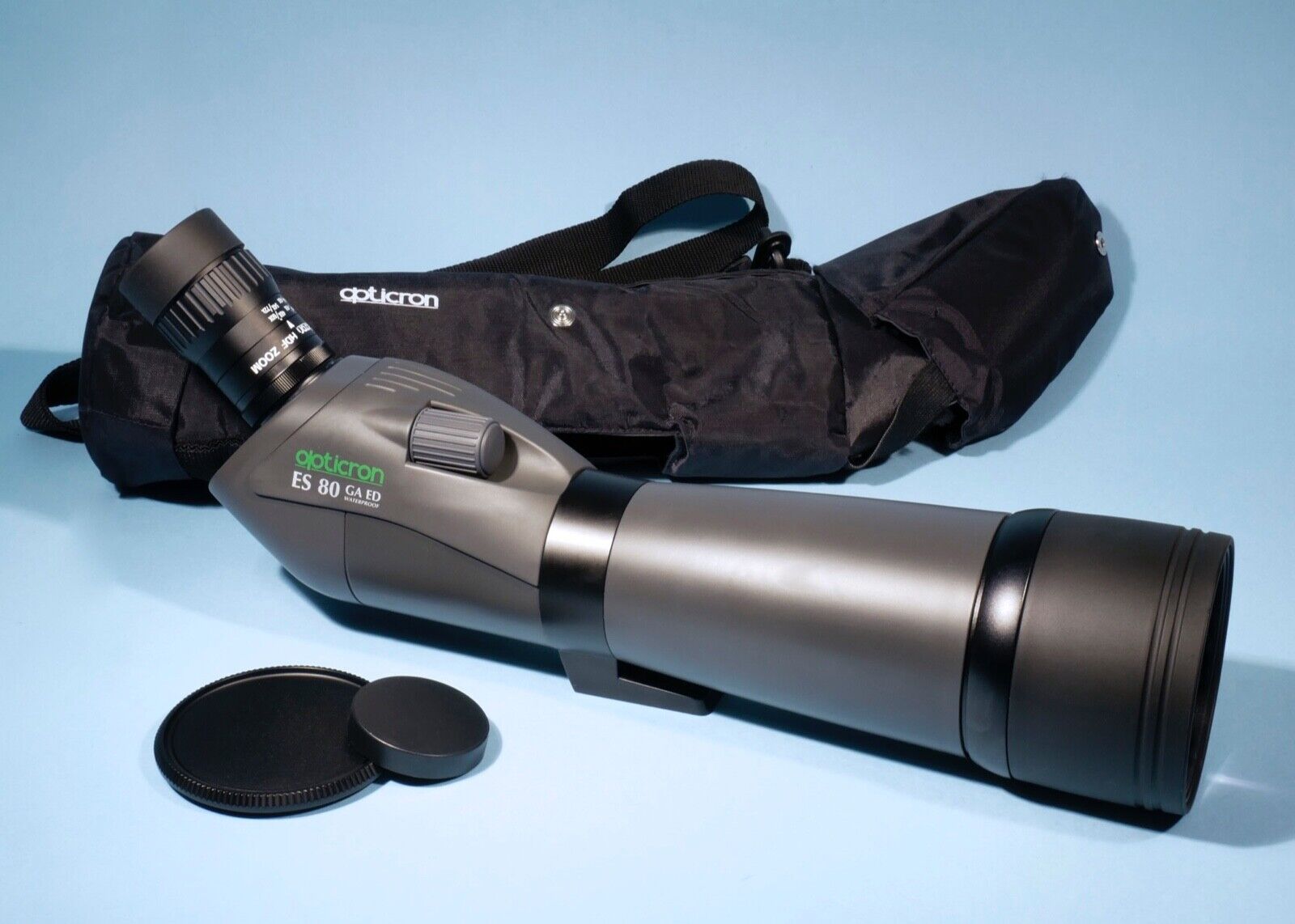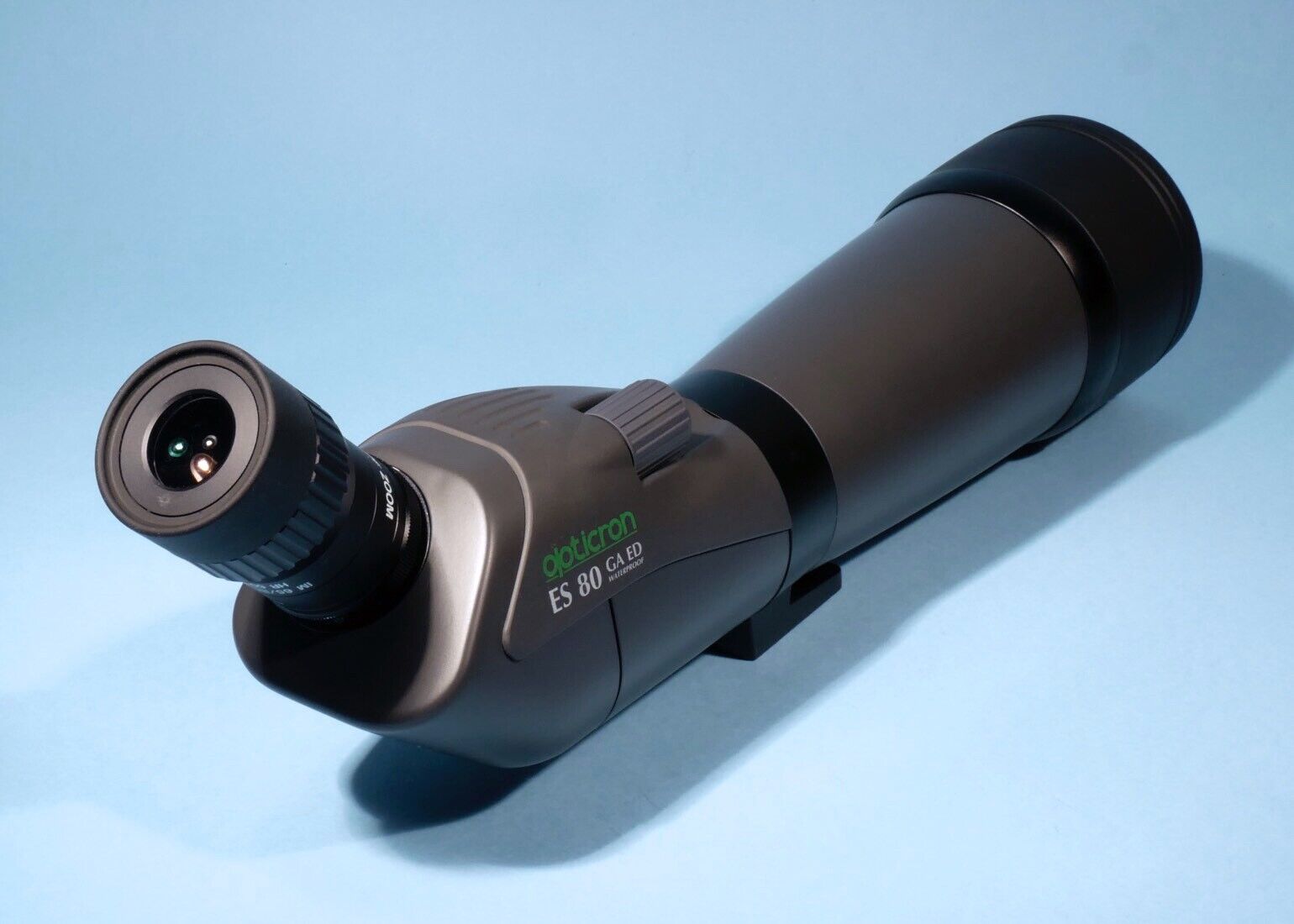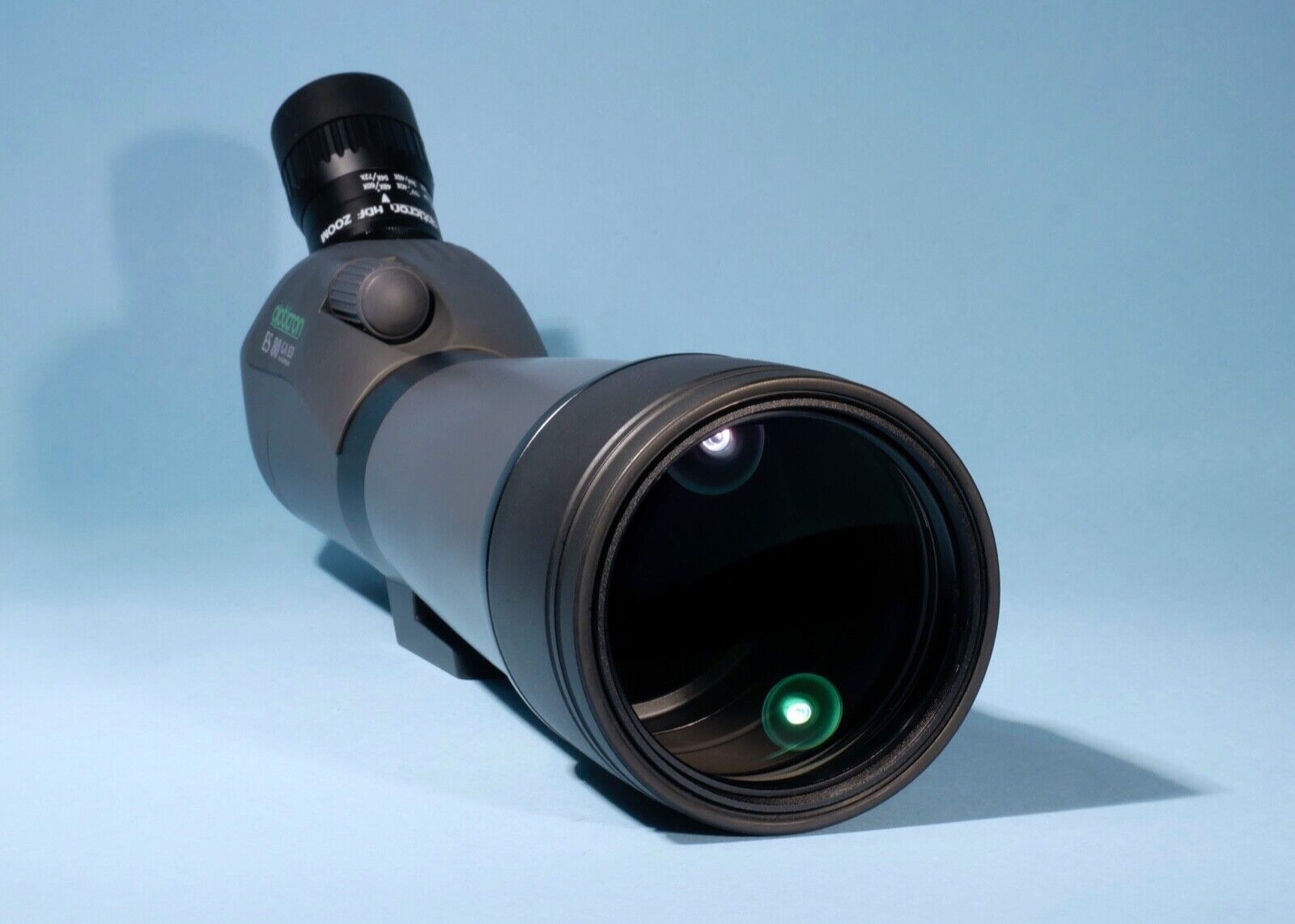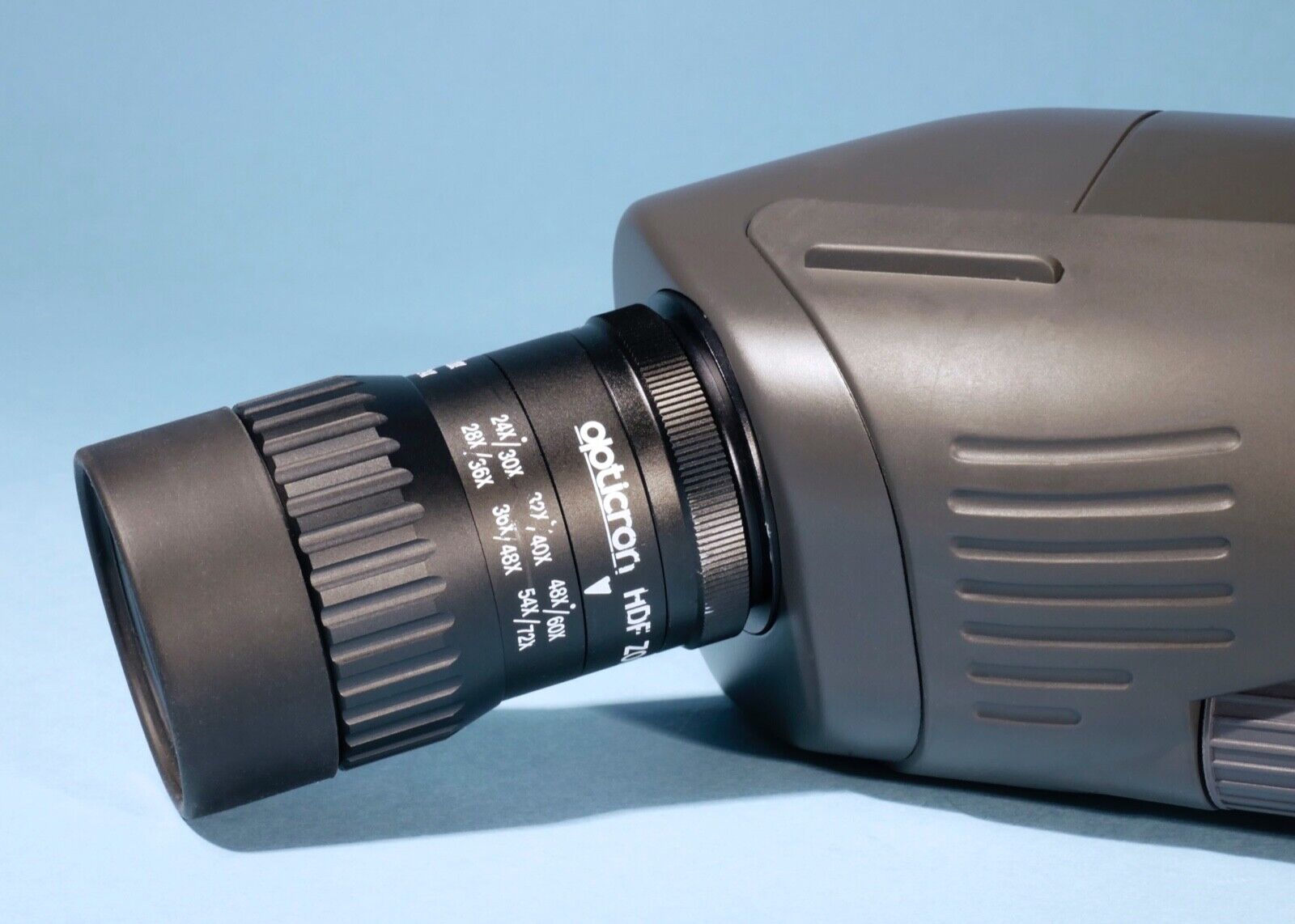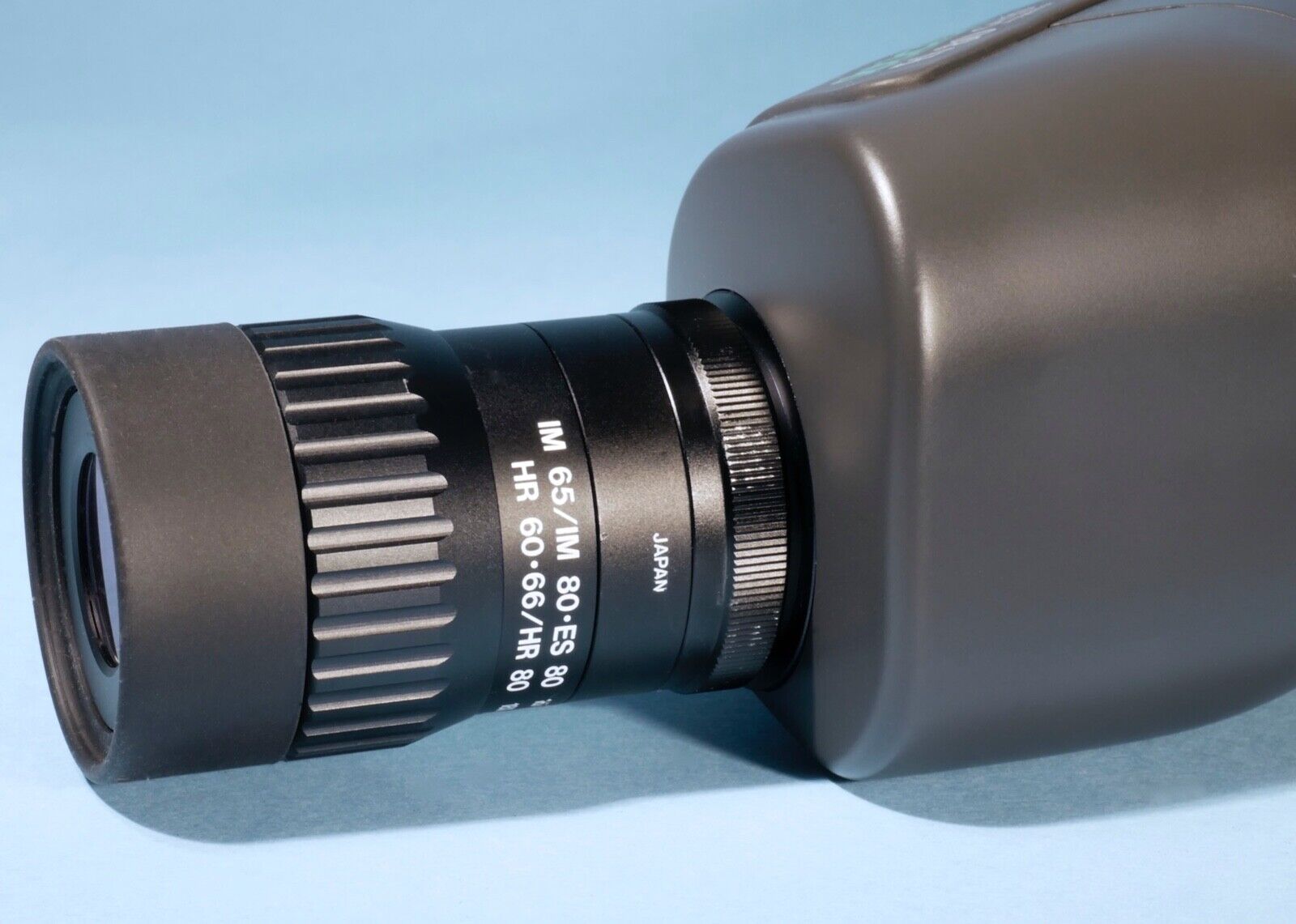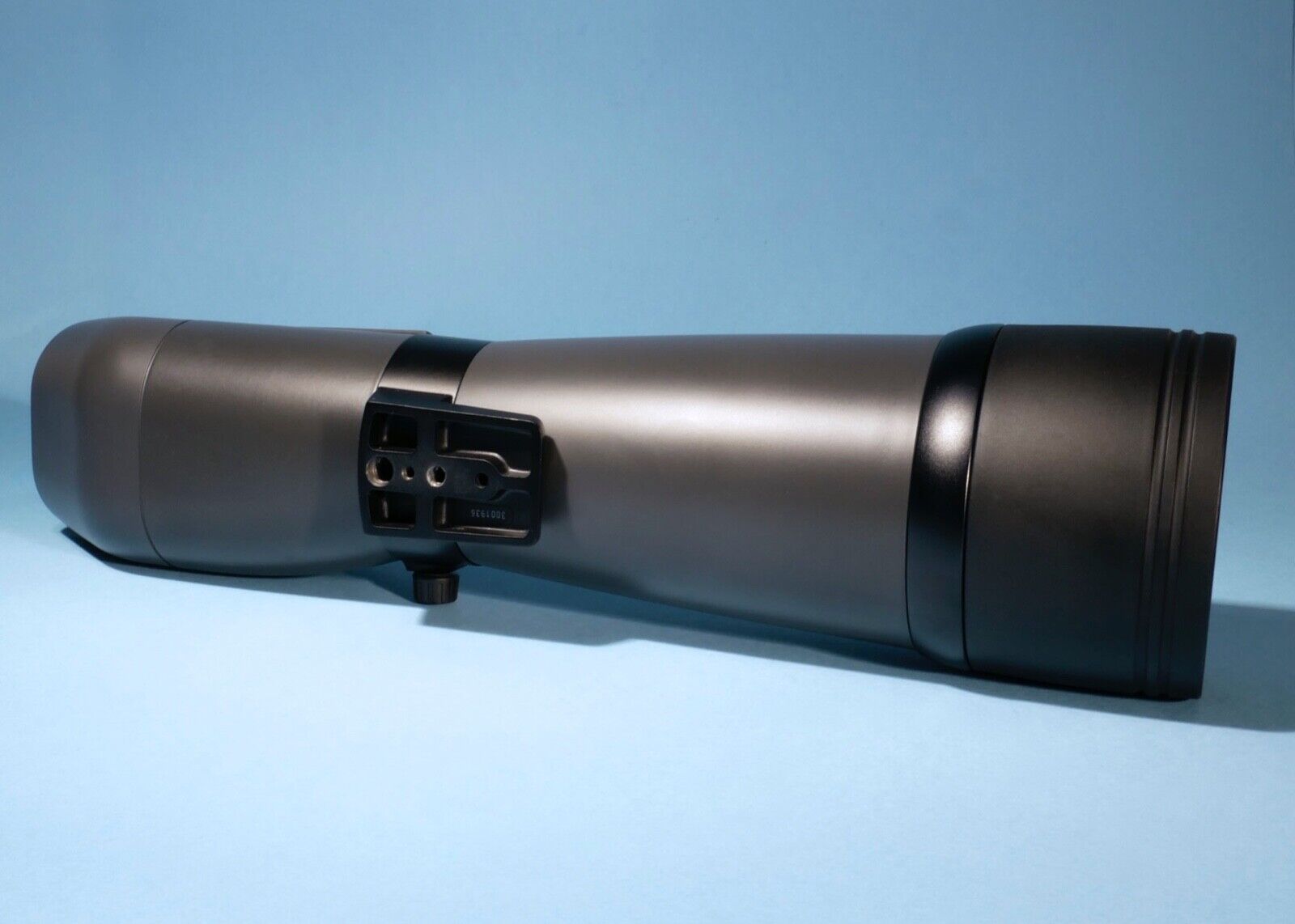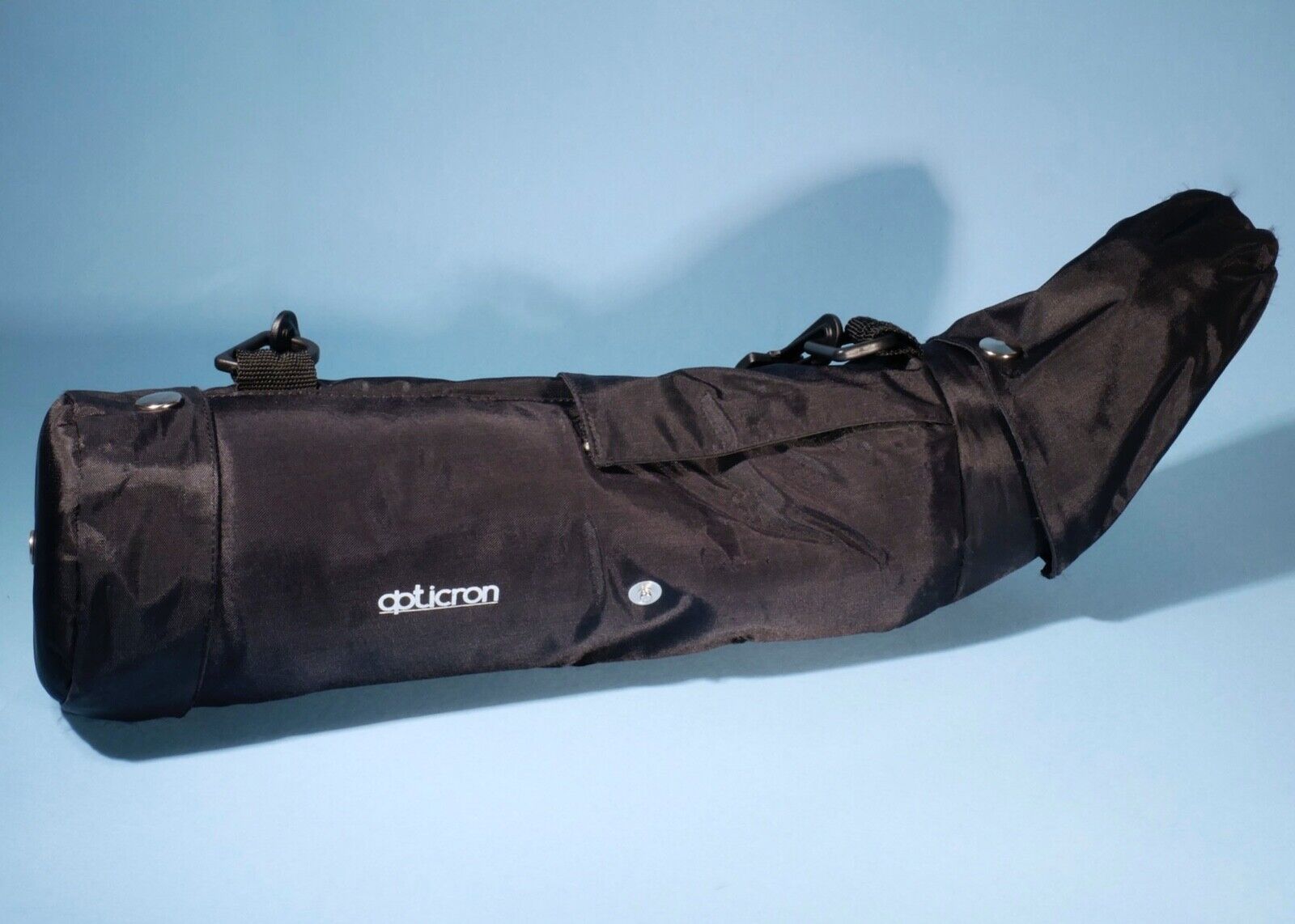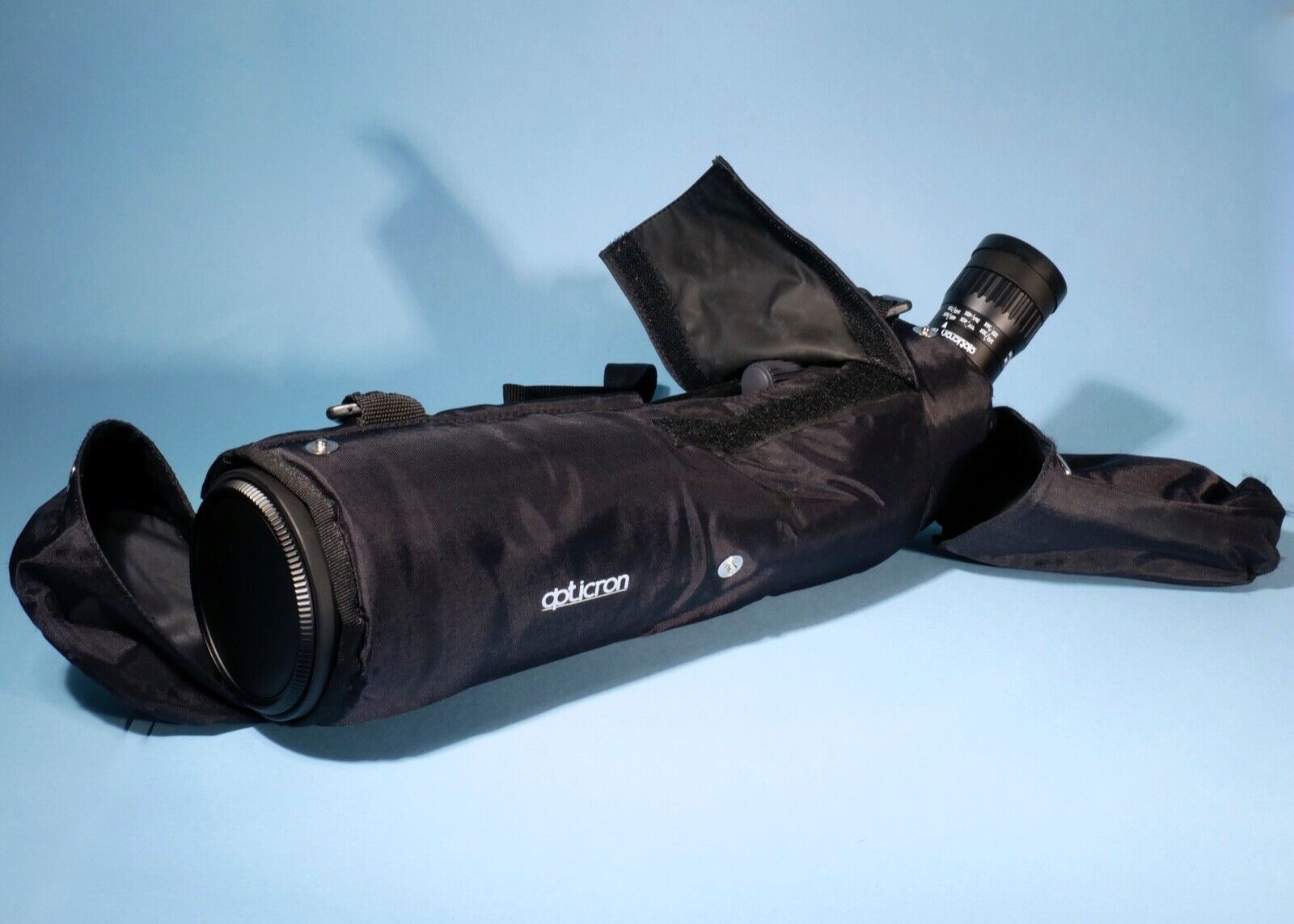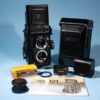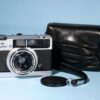Opticron Spotting Scope ES80 GA ED Waterproof + 20-60x Eye Piece & Stay-on-Case
£349.99
Out of stock
In recent years, the Opticron ES 80 has been a relatively popular telescope in Finland, mainly because it has been priced significantly below the top scopes of the traditional big names in the business, while offering reasonably good image quality and handling convenience. The ES 80 GA ED is an update of this telescope, and according to Opticron it features redesigned optics as well as a fully rubber-armoured body.
In the spring of 2007, Alula was offered the opportunity to test this new scope, and here we report on these tests and field trials. However, the test did not get off to a good start, since the scope we received from England for testing turned out to be faulty. The image was blurry and tiring to the eye, and the resolution test results were poor for a scope of this size. A star-test revealed a mixture of astigmatism and miscollimation severe enough to result in prominent flare even at optimum focus. With the assistance of the Finnish importer, we exchanged the faulty scope for the best sample chosen from five other scopes (all of which ranged from good to excellent when judged by their freedom from aberrations). This new sample has an unusually small number of optical aberrations for a birding scope. This made it exceptionally interesting to test, since I did not need to speculate about how the image might be compromised by assembly defects and quality variations. Ever since the first two telescope tests that I carried out, my practice has been to use a star-test to check that the tested unit is not a “lemon.” Also, whenever it has been possible to screen several samples, I have picked the best available unit for testing.
I tested the Opticron ES 80 GA ED with resolution targets and in the field against my reference telescope, the Nikon Fieldscope ED 82 A, in the same manner as in my previous telescope tests. I had the scope available for a a sufficient length of time to allow me to use it in all types of weather and in many different light conditions. All the viewing and tests were carried out with the zoom eyepiece attached.
Technical properties and usability
The ES 80 GA ED is waterproof and nitrogen-filled. The body is partly made of cast alloys, partly of polycarbonate, and is fully rubber-armoured with the exception of the tripod foot collar that circles the body. The retractable lens hood feels solid and slides in and out with the right amount of resistance. The tripod foot is large, made of metal alloy and feels solid. It features both 3/8” and 1⁄4” threads as well as a hole for the securing pin found in video heads. The tripod foot collar allows for a full 360° rotation of the scope along its axis. The scope generally feels very sturdy (considerably less plastic than its predecessor), but for an 80mm scope it is rather heavy and large. For comparison, the Kowa 883 we tested recently provides a 10% larger objective in a package that weighs almost exactly the same and is five cm shorter. The focus knob is wide enough to be operated by two fingers, moves smoothly and precisely and is easy to use even with gloves on. I found the focus speed a good compromise for a “single speed” design, but focusing between very close and distant targets does take a fair amount of time.
The eyepiece is offset to the right, so aiming at flying birds without a “cable tie sight” (see Alula, 1/97, Birding, december 1998) or a similar device is not that easy. The rubber objective cover is tethered with a wide rubber ring that sits between the scope body and the retractable lens hood. It is of a simple press-on type, and worked well at least in the above-zero weather I used it in. It is also easy to remove altogether if one uses the stay-on case and wishes to keep things simple. The zoom eyepiece attaches with a threaded mounting ring, which is quick enough to use and holds the eyepiece securely even while zooming. Since Opticron has such an extensive range of scopes, the zoom has a veritable jungle of various magnification markings printed on it, though one set actually corresponds (at least roughly) to the magnifications obtained through this scope. The eye-relief of the SDL zoom is exceptionally long but, as usual for most zoom lenses, does not remain constant throughout the zoom range. I measured 27mm @ 20x, 18mm @ 40x, and even at 60x the eye-relief was 17mm. The eyepiece is therefore very well suited to spectacle-wearers, but the price for this is that field of view is modest even for a zoom eyepiece. I measured 28 metres at 1 km at 20x, which is a little less than even the Nikon zoom gives at its minimum magnification of 25x. At magnifications over 40x the field width begins to approach that of the competition, but even at 60x the subjective field is still under 60°. Opticron offers 13 other eyepieces that fit the ES 80. These include HDF wide-angles from 23x to 80x magnification as well as a 100x standard eyepiece for those who are interested in the night sky. Along with the scope, we were provided with Opticron’s custom view- through case for the ES 80 GA ED. It is made of green cordura nylon, thickly-padded and rather well designed. The objective and focus wheel cover flaps fasten with Velcro strips, and when open can be fastened out of the way with snaps. An eyepiece cover that looks like a mitten uses snaps for both positions. Both the eyepiece and objective covers are tethered to the case to prevent loss. In the field, the case was very practical, but the undersized snaps needed careful aiming to close and opened too easily on their own. The case adds some 300g to the scope’s weight, but certainly offers it good protection against scratches and bumps. Opticron’s warranty is 10 years.
Optical performance
Both with test targets and in the field, the resolution of the ES 80 was very good, but the difference when compared to my reference (which is more or less equally aberration-free) was greater than should result from the nominal 2mm difference in objective size. I thus measured the real effective aperture of the Opticron, which turned out to be 78-79mm. Thus, the scope does not quite meet its specification here, but such a small difference should not matter much. With the resolution target I used, the Opticron allowed me to resolve circa 13.7 line-pairs at 10-metres, while my reference scope cleared 15.4 line-pairs/mm. The Opticron snapped to focus very decisively and easily, and the focused image was easy and non-fatiguing to view. The 60x maximum magnification was fully usable, but at this magnification the image was no longer particularly bright or contrasting. Viewed with a 3x booster, the scope’s image still looked very clean and aberration-free, and without a reference or prior data at hand I would have concluded that it resolves as well as a scope of this size is capable of. Switching to the Nikon then revealed that there is still some room for improvement – a line pattern that was relatively clearly resolved with the ED 82 A simply did not resolve with the Opticron. Contrast in the ES 80 GA is good but not at the level exhibited by the Kowa 883, the Nikon or Swarovski’s ATS 80 HD. The contrast is a bit flat and colour hues lean a bit towards yellowish-grey. In brightness the Opticron trails the Nikon rather markedly. Here we are probably seeing the inherent limits of the prism construction used in the Opticron. In theory, this cluster of two porro-prisms and a mirror- coated semipenta-prism loses more light than the monoblock Schmidt-prisms used by Kowa (in the 773/883), Nikon (Fieldscopes), Swarovski and Zeiss, and even in full daylight the difference was clearly visible. However, if we compare the Opticron to scopes in other price segments, its brightness is very competitive. The colour balance of the ES 80 GA ED is relatively neutral with a slight yellowish bias. Colours are good, but in a direct comparison to the Nikon, they do not look as vivid. Despite the ED-lens element, it is also relatively easy to see some visible residual chromatic aberration, which somewhat compromises natural colour rendering. For its ability to transmit colours accurately, the ES 80 GA ED is pretty close to the old Swarovski AT 80 HD but a clear step behind the Kowa 883, the Nikon and Swarovski’s newer ATS 80 HD. Flare is superbly controlled in the new Opticron. Even in the most glaring backlight situations I had no
problems with spurious reflections, and also when viewing the night sky the stars remained compact points of light with no unwanted scatter. In general ease of viewing, the ES 80 GA ED is likewise excellent save for the fact that the rather dramatic increase of eye-relief when zooming down from around 40x forces one to adjust the eyecup and re-position one’s eye. In other respects, eye placement was problem-free, the view was easy on the eye and caused no fatigue even in long stretches, and focusing was quick and certain. Image quality near the edge of the field is superb from 20x to beyond 40x, and remains very good between 50-60x. The price for the sharp edges is a field of view that is significantly narrower than usual at all magnifications, leading to a somewhat unimpressive, tube-like viewing experience. This new Opticron zoom is also unusually far from being parfocal, meaning that substantial refocusing is always necessary after adjusting the zoom. However, since with even the best zooms it is necessary to refocus a bit at least after zooming from low to high magnifications, I did not find this shortcoming particularly bothersome.
Conclusion
Especially considering its price, the Opticron ES 80 GA ED is a very good birding scope, and deserves a recommendation for those unwilling to spend significantly more. An image which holds up this well up to 60x magnification, staying sharp, clean and free-of-fatigue even in prolonged viewing, has pretty much been the sole territory of the “name brands” until now. As for negatives, the zoom does have a rather narrow field of view, and the scope is somewhat large and heavy for its class. Image brightness, contrast and colour saturation are not quite as good as in the best of the competitors, but even in these areas the Opticron performs well – more or less what the best scopes could achieve some ten years ago. In addition, the scope’s relative immunity to flare in difficult backlight situations can often be an important asset in the field.
Any questions, please ask.
International buyers are welcome.
If you have any problems with the delivery or the item, please let me know so I can resolve it!
All deliveries will be Tracked and Signed-For, I also pack all items to high standards.
Please buy with confidence and check out my other items.
Thanks for looking
*****
| Brand | Opticron |
|---|---|
| Type | Spotting Scope |
| Size | Full-Size |
| Maximum Magnification | 60x |
| Features | Waterproof |
